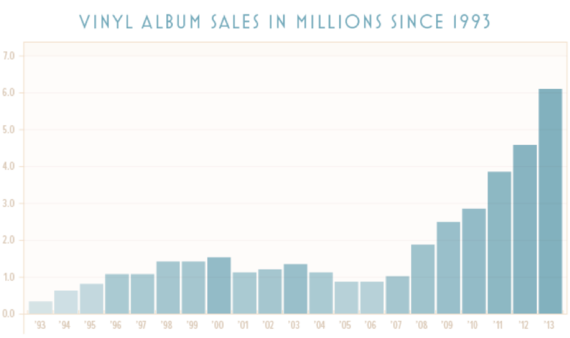Whilst Noel Gallagher's High Flying Bird's latest album, Chasing Yesterday, may contain a song with the title 'You Know We Can't Go Back', the album has been caught up in the whirlwind revival of the ancient format of vinyl. Chasing Yesterday sits at the top of the vinyl album chart and three of its songs at the top three places in the vinyl singles chart. Vinyl, which dates back to the mid 19th century, was the predominant commercial format of music available, even withstanding the cassette tape, until the compact disc in 1983.
Nowadays, music is digitally available at our fingertips, with catalogues of artists sitting in our pockets. Never before has it been as easy or as cheap as it is to access music than it is today. Nevertheless, in a strange parallel to music becoming easier to source, vinyl sales are on the increase, with the first three months of 2015 seeing a 53% increase in sales from the first three months of 2014. According to Pitchfork, vinyl sales sat below 1 million during the first half of the nineties, peaking at around 1.5 million at the turn of the century but then declining again to below 1 million between 2005 and 2006. Since 2006, vinyl sales rapidly increased from 1 million to 6 million in 2013.

Vinyl enthusiasts are loyal to the claim that vinyl simply sounds better. Indeed, the meticulously engraved groves educe a crisper, more authentic sound. Scientifically, the groves mirror the original sound's waveforms, resulting in no information loss, whereas digital music does not capture the entirety of the waveform. The end result is a more accurate and richer sound. Due to the transparent nature of the transmission of music through vinyl, dust particles often fill silences in the recording with noise, whereas digital transfers complete silence. Vinyl enthusiasts often find the rustling static as part of the intrinsic beauty of the format itself. Vinyl certainly is a beautiful format. Even visually, music lovers can appreciate the artwork of the album much more due to the sheer physical size of the LP.
For hipsters, whose trend setting outlook relies on rebirthing vintage gems to compliment their image, vinyl is thereby the perfect source of nourishment. It's 'cool' to own records and a record machine. It's a hobby that fosters a great deal of respect from genuine music lovers, but then again, it's an easy hobby to fake; all it takes is a bit more cash and a bit more space than a CD collection.
Therefore, is the peak in vinyl sales a reflection of the growth of hipsters or the growth of genuine music lovers? Ultimately, we won't ever uncover the answer, as no one is outwardly a self-confessed hipster - denial is the hipster game. Nevertheless, we can still assess the value of vinyl; is it really that much better than listening to music through 21st century inventions such as Spotify? So far, science says yes and music fanatics say yes, but what about the practical aspect? Once you've forked out the extra cost for vinyl (often at least 1.5x the cost of a CD, if not 2x), the record can't be listened to on the tube or in your car or at the gym. Even when listening to the record at home, the album can't be listened to in its entirety without it being flipped, which means you can't just leave it to play for too long unattended. Modern day technology has even developed vinyl to make them heavier, with deeper and richer sounds, which results in fewer tracks per side. For example, the 2014 180g reissue of Oasis' Definitely Maybe is a two-vinyl release, with only three tracks per side - furthermore, it'll set you back £33.99 on amazon, compared to the £5.49 reissue equivalent. Note that the original 1994 CD recording is a whopping £30 less than the 2014-reissued vinyl at just £3.99.
This thereby suggests that whilst vinyl produces a more authentic sound, it also results in a great deal of inconvenience, at a much greater cost. This means that those who are committed to vinyl must sincerely cherish the qualities that the vintage format has to offer. Having said that, those who do own record collections are not monogamously restricted to the format. Indeed, personally, I own a few records and appreciate the analogue sound enhancement, but I also use Spotify on a more regular basis. There is also a charm in visiting record shops and discovering gems amongst the dust piles of old records at discounted prices; to this extent it can simply be a collector's hobby.
To sum up, vinyl is undoubtedly a more authentic reflection of the original recording, but is an unpractical format in today's society. Nevertheless, music lovers and collectors will delve into the realms of record collecting and will emphatically cherish the format, whilst hipsters will jump on the bandwagon to gain credibility. The surge in record sales suggests that the market is reviving the vintage format, perhaps out of curiosity, but it also seems that the market is genuinely succumbing to the merits of vinyl. It will be interesting to see whether vinyl sales continue to rise or whether it is just this decade's phase.
Image: Pitchfork